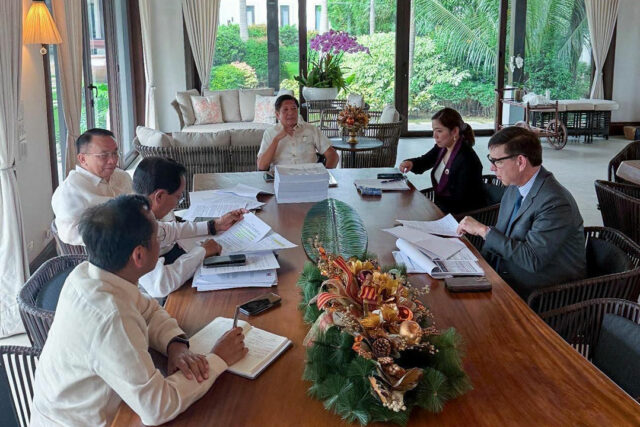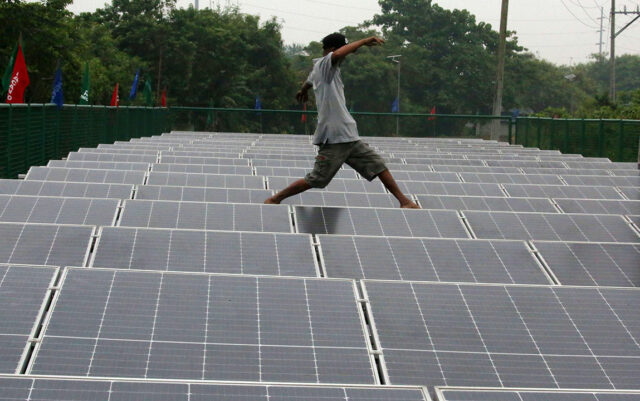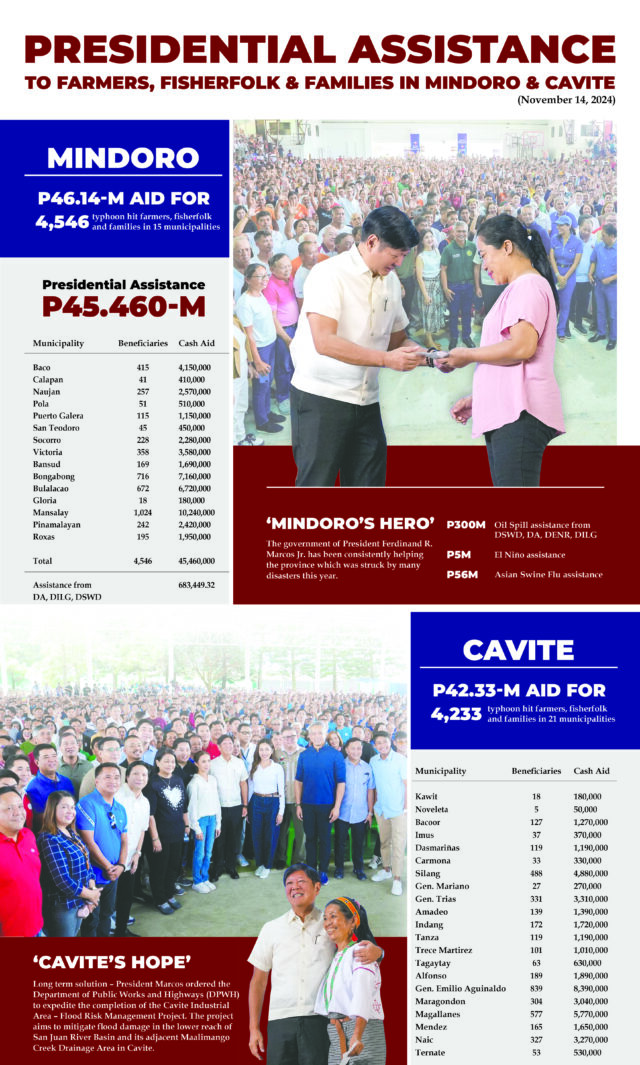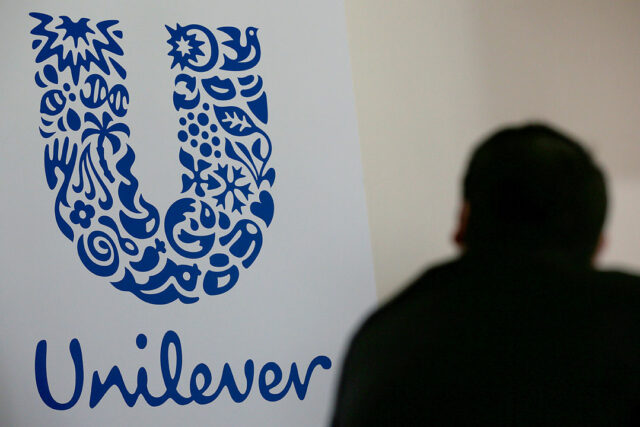Marcos postpones budget signing amid backlash

By Kyle Aristophere T. Atienza, Reporter
PRESIDENT Ferdinand R. Marcos, Jr. has postponed the signing of the proposed 2025 national budget that was originally scheduled for Dec. 20, according to his office.
The postponement was announced just as workers’ groups staged a protest near Malacañang against what they called as the “most corrupt” spending plan in Philippine history.
Executive Secretary Lucas P. Bersamin said in a statement on Wednesday that the delay in the signing would “allow more time for a rigorous and exhaustive review of a measure that will determine the course of the nation for the next year.”
“While we cannot yet announce the date of the signing, we can now confirm that certain items and provisions of the national budget bill will be vetoed in the interest of public welfare, to conform with the fiscal program, and in compliance with laws,” he added.
Mr. Marcos held a meeting on Wednesday afternoon with his economic managers to ensure next year’s budget is aligned with key development priorities, according to the Presidential Communications Office.
Present during the meeting were Finance Secretary Ralph G. Recto, Budget Secretary Amenah F. Pangandaman, Public Works Secretary Manuel M. Bonoan, and National Economic and Development Authority Secretary Arsenio M. Balisacan. No other details were available.
Mr. Marcos on Monday said he’s not keen on issuing a line-item veto, which is allowed by the 1987 Constitution in bills related to appropriations or tariffs.
Major issues hounding the P6.35-trillion national budget for next year are the cut in the Department of Education’s (DepEd) budget and the removal of state subsidy for the Philippine Health Insurance Corp. (PhilHealth), the key agency in implementing the Universal Health Care program.
In the bicameral conference committee report ratified by Congress, the funding for DepEd and its agencies was cut by P11.15 billion, while PhilHealth will not receive its P74-billion government subsidy amid concerns on its failure to use its reserves in the past years.
DepEd, in particular, was denied its proposed P10-billion funding for its computerization program for 2025 due to its failure to spend previous budgets for a similar program as early as 2022.
It reported an obligation rate of 41.9% as of August, ranking 11th among government agencies in terms of budget utilization. Still, the rate is still higher than that of Congress, which had the lowest obligation rate at 8.8% but has received a P16.35-billion increase in the bicam’s version.
Anthony C. Leachon, a health reform advocate who had worked with the Department of Health (DoH) in the first year of the Marcos administration, said the President had likely “felt the mounting pressure from the civil society, business sector and other stakeholders and the public interest is paramount.”
“What’s the legacy of (Mr. Marcos) as a president if he would turn a blind eye,” he said. “I believe he has been misguided by lawmakers who wanted to shift the formal funding for PhilHealth for pork barrel.”
Some economists have discussed in public fora the implications of removing the subsidy for PhilHealth, which they said had assets lower than its liabilities.
“(Mr. Marcos) stands at a crossroads and his decision on this budget will define his character and presidency,” Mr. Leachon said. “He should veto the 2025 GAA (General Appropriations Act) and prioritize the health and dignity of the Filipino people.”
Senator Mary Grace Natividad S. Poe-Llamanzares, who was part of the bicam, said the President’s decision to postpone the budget signing is “a sign of a healthy democracy.”
“We have to support the checks and balances of our budgetary process,” she said in a Viber message. “I believe his economic managers are giving the President the best advice possible given the situation.”
Speaking to reporters on Monday, Mr. Marcos said PhilHealth has “sufficient funds to carry on” despite the removal of state subsidy.
‘USELESS’
Public finance expert Zyza Nadine Suzara said the President should restore the funding for all the development programs that were cut from the budgets of DepEd, Department of Social Welfare and Development (DSWD), DoH, and the Commission on Higher Educations, among “many others.”
“But the way to do that is not through an ‘assessment’ with department heads or a presidential veto. Neither an assessment nor a direct veto will cure the grave mistakes of the bicam,” she said in an X message.
“This process will not restore the slashed funds from the various major departments, and most especially, the line items that were struck down,” she added.
The DPWH’s allocation in the Congress-approved budget rose by P288 billion from the initial proposed P1.1-trillion funding.
As the agency responsible for most of the government’s flagship infrastructure projects became a net gainer, agencies responsible for key social services faced massive cuts.
The budget of DSWD declined by P95 billion from its initial proposed P217.3-billion funding, while that of DoH fell by P25.7 billion from P247 billion.
Ms. Suzara said the President can only cure the budget by returning the ratified budget to the bicam and asking them to “reconvene so that they can swiftly remedy the most corrupt and anti-poor budget we have ever had.”
“They should prioritize the needs of taxpayers and not their personal political ambitions.”
Enrico P. Villanueva, who teaches money at the University of the Philippines Los Baños, said the massive budget increase for DPWH is highly questionable as only 11 or 6% of the 186 flagship infrastructure projects of the government are expected to be ongoing by 2025 and only 51 of them are to be funded by the GAA.
Eighty-six out of the 186 flagship projects are funded by official development assistance, while 43 of them are under the private-public partnership scheme, he added.
“Legislators cited the low budget utilization rate of DepEd and PhilHealth as basis for reducing their budget, but these same legislators also castigated DPWH for its low budget utilization rate at 58% in 2023 and ineffective flood control projects,” Mr. Villanueva pointed out.
Meanwhile, the Nagkaisa Labor Coalition, which held an indignation protest near Malacañang on Wednesday, dubbed the proposed 2025 national budget as the “most corrupt” spending plan in the country’s record, citing the diversion of funds to patronage-driven programs such as the Ayuda sa Kapos ang Kita program and the Medical Assistance for Indigent and Financially Incapacitated Patients program.
Lawmakers, which are mandated by the 1987 Constitution to legislate laws, have been present in the distribution of these cash-aid programs.
Nagkaisa Chair and Federation of Free Workers President Jose Sonny Matula said the government is “using workers’ own contributions against them while leaving them burnt to a crisp.”
“Perceptions by the general public that basic services are being taken away from citizens would lead to an increase in public protests, so it is important the President is aware of the needs of the populace,” said Ateneo School of Government Dean Philip Arnold “Randy” P. Tuaño.










